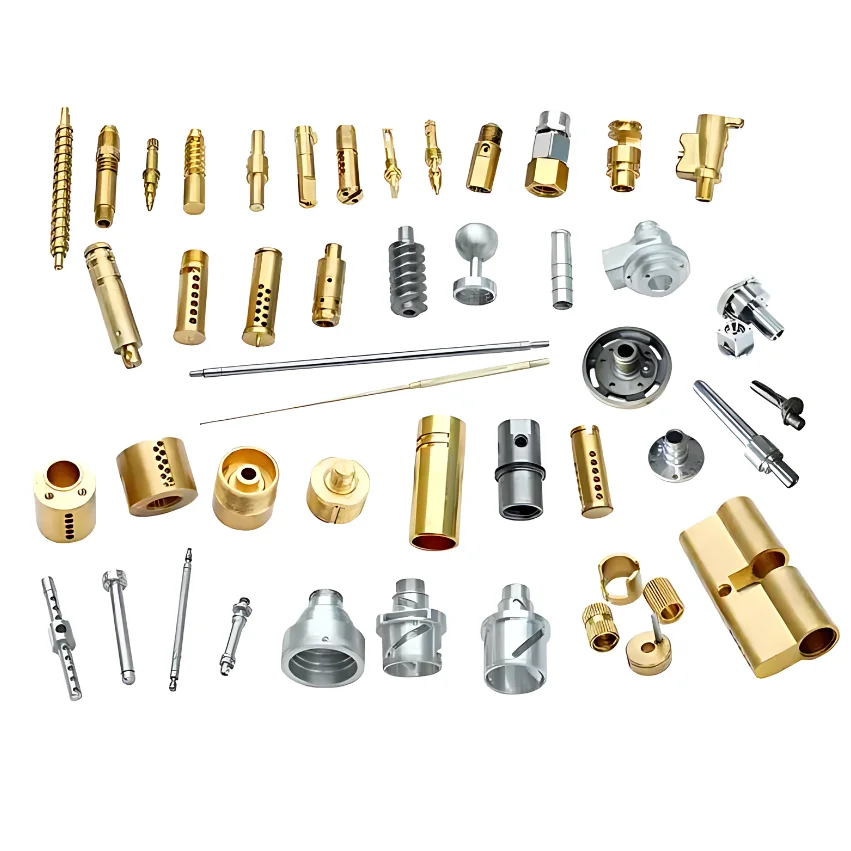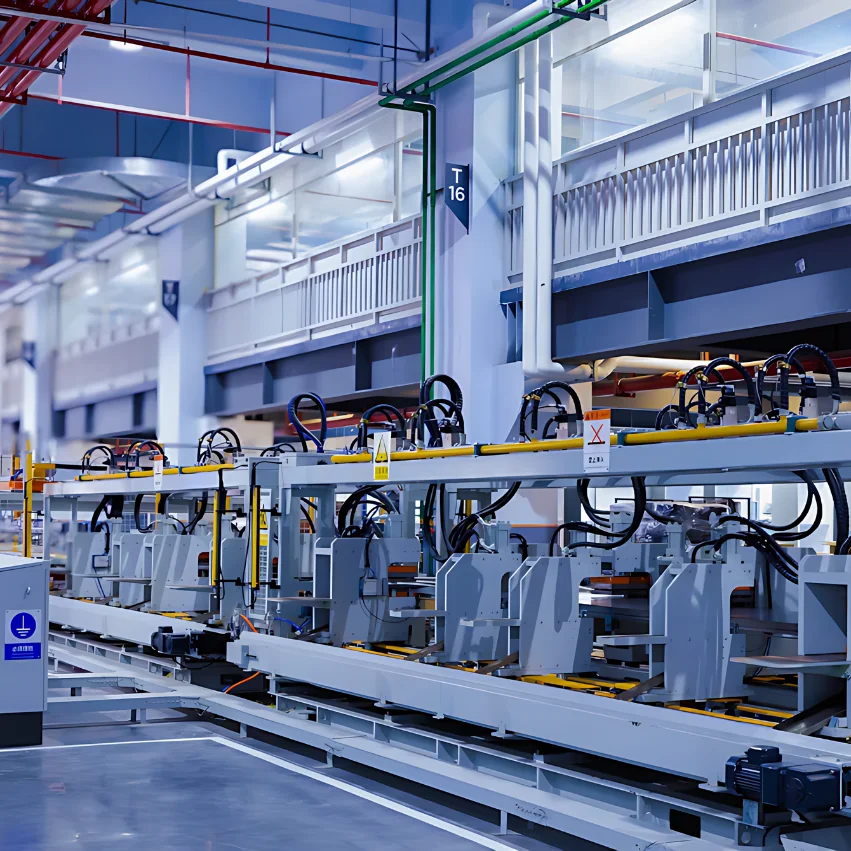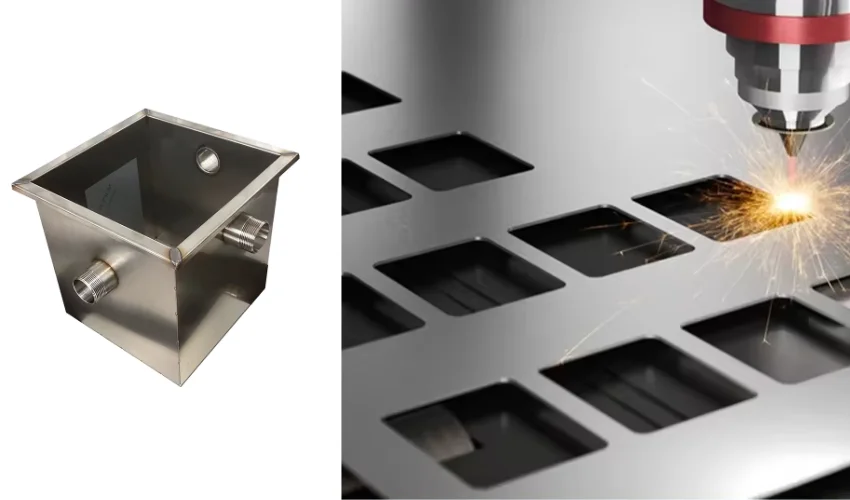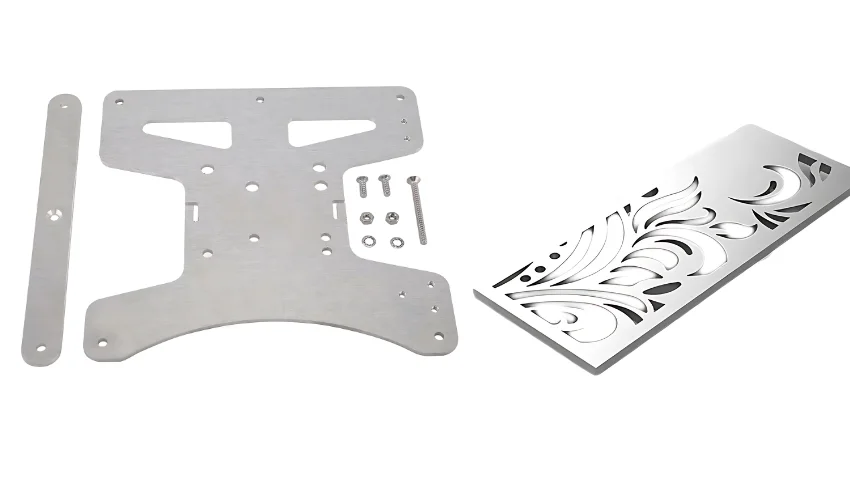Laser-cutting aluminum combines the twin benefits of precision engineering and process adaptability. At its core, it uses a concentrated beam of light to precisely cut or engrave aluminum panels. The purpose of this blog post is to demystify the intricacies of laser cutting aluminum and explain the mechanics behind it.
What is Laser Cutting?
Laser-cutting machines utilize the power of a highly concentrated laser beam to make complex and precise cuts in materials. This laser beam is directed at the material through precision optics combined with computer numerical control (CNC) technology to make fine cuts in accordance with a programmed pattern or G-code.
As the laser moves across the material, its focused spot, which can be as small as 0.0125 inches (0.32 millimeters) in diameter, intensely heats, melts, vaporizes, or burns the target, supported by jets of gas that help expel the molten material
Laser cutting machines are particularly effective on aluminum and can handle all types of aluminum and alloys with precision similar to CNC machining.
Types of Laser Cutting
The main types of lasers used for laser cutting are CO2 lasers, Nd (Neodymium) lasers, Nd: YAG (Neodymium-doped Yttrium Aluminum Garnet) lasers, and Fiber lasers, each of which has unique properties for a particular application.
CO2 Lasers: CO2 lasers use direct current or radio frequency energy to excite a gas mixture. This technology can cut materials such as titanium, stainless steel, and fabric. They excel in cutting, drilling, and engraving.
Nd and Nd: YAG Lasers: Neodymium (Nd) and Neodymium-doped Yttrium Aluminum Garnet (Nd: YAG) lasers are similar in style, but differ in application due to their different energies and repetition rates. Neodymium lasers are suitable for high energy, low repetition rate drilling, while Nd: YAG lasers are suitable for high-power drilling and engraving.
Fiber Lasers: Fiber lasers use a solid gain medium. These lasers amplify light within a glass fiber, producing a beam with a very small focal diameter, perfect for cutting highly reflective metals. Fiber lasers are more energy efficient and require less maintenance than CO2 lasers.
Do you want to know or are you looking for a reliable service provider? Shanghai Vito Hardware Co., Ltd. will provide you with the best service and products. If you want to get the service you need, please contact us.
Our services are trustworthy. Our product quality is strictly managed according to ISO9001 standards. We have a team of skilled engineers who can answer your questions and help you make plans. You can get all of these services at a low price.
How Does Laser Cutting Aluminum Work?
Laser cutting aluminum involves a precise and controlled process that begins with a design, usually created in CAD (Computer Aided Design) software.
The design will guide the laser cutter as it directs a highly focused and collimated beam of light to precisely cut the aluminum. The intense light from the laser heats the aluminum, causing it to melt and vaporize in a specified location.
A high-pressure gas jet then expels the melted material, allowing the laser to penetrate deeper and create a clean, sharp cut along the desired path.
How Does Laser Cutting of Aluminum Work?
Preparation: Clean the aluminum surface and fix it on the cutting table to ensure stability during the cutting process.
Parameter Setting: Setting key parameters such as laser power, CNC feed speed and path, type and pressure of auxiliary gas, and nozzle position. This stage may require trial and error to perfect the parameter settings.
Cutting Process: A focused laser beam is directed at the aluminum surface, rapidly heating, melting, and vaporizing the material. Auxiliary gases, such as nitrogen, are used to blow away the molten metal and clear the cutting path.
Cooling: As the laser beam advances along the cutting path, the auxiliary gases also help to cool the newly cut section, preventing any thermal distortion
Effectiveness and Types of Lasers
Laser cutting is very effective in cutting aluminum because of its high precision and speed compared to traditional cutting methods. The process usually uses fiber lasers and CO2 lasers:
Fiber Lasers: Fiber lasers are known for their high energy efficiency and excellent beam quality, and are particularly suitable for cutting aluminum up to 25 mm thick.
CO2 Lasers: They use a mixture of carbon dioxide, nitrogen, and helium, activated by a laser or arc source. They are cost-effective for a wide range of materials, including thicker aluminum panels typically exceeding 6 mm in thickness.
Aluminum Plasma Cutting: Plasma cutting uses a high-speed jet of ionized gas to melt and remove metal for a clean, precise cut. However, plasma cutting has a wider heat-affected zone and rougher edges than laser cutting.
Advantages of Laser Cutting Aluminum
Laser-cutting aluminum offers numerous advantages and is the method of choice for a variety of applications due to its precision, speed, and flexibility. Here’s a look at why this technology is revolutionizing industrial manufacturing:
- Precision and Accuracy: It enables intricate and fine cuts to be made and maintains tight tolerances that are vital for high-specification projects.
- Speed: Laser cutting is significantly superior to traditional cutting methods. Its ability to cut aluminum quickly reduces production time and allows for efficient handling of large orders. It also minimizes downtime between production cycles, increasing overall productivity.
- Flexibility: It can process different thicknesses of aluminum and easily switch between different cutting designs without the need for additional tools.
- Cutting Quality: The non-contact nature of laser cutting means that there is minimal mechanical stress on aluminum, helping to prevent deformation and twisting of the material. This results in a superior-quality finish with clean, burr-free edges that require virtually no finishing.
- Reduced Material Waste: The precision cutting of laser cutting saves money by making better use of the material.
- Integration with Automated Systems: Laser-cutting technology can be seamlessly integrated into automated production lines. It is compatible with advanced manufacturing technologies such as robotic systems and computer-aided manufacturing processes, streamlining production processes and reducing human error.
Applications of Laser Cut Aluminum
Laser-cut aluminum is used in a wide range of industries because of its precision, flexibility and efficiency. Here’s a deeper look at its applications:
- Automotive: In the automotive industry, laser cutting is used to manufacture complex and precise components such as engine parts and trim parts. The technology is capable of adhering to strict tolerances and creating complex shapes.
- Signage: Aluminum is the material of choice for signs and artwork because of its durability and excellent finish when laser cut. Laser cutting produces detailed designs and crisp, clean cuts.
- Aerospace Components: In aerospace components, every gram and inch must be precisely calculated. Laser-cutting machines are able to handle a wide range of aluminum thicknesses while maintaining tight tolerances.
- Medical Devices: Laser cutting is key in the medical field for the manufacture of pacemakers, stents and catheters. It provides a sterile, non-contact method of cutting precise designs in sensitive materials, ensuring a clean cut that meets strict medical standards.
- Jewelry Making: It can be used to cut precious metals and etch designs into surfaces, giving jewelers the ability to create unique and intricate jewelry.
- Ceramics: Laser cutting extends its use to the ceramics industry, allowing precise cutting and engraving of designs on brittle materials without the risk of breakage. It is perfect for creating decorative elements on tiles and pottery.
- Silicon Manufacturing: In the area of silicon manufacturing, particularly electronics, CO2 lasers can precisely create micro-scale features on silicon wafers.
- Woodworking: It is used to create fine decorative elements and joinery components. It can be used for complex designs of furniture and architectural elements.
Read More:
How to bend sheet metal: a step-by-step guide
12 types of milling operations
Choosing the Right Laser Cutting Parameters
Choosing the right laser cutting parameters is key to achieving high-quality cuts, especially when processing materials such as aluminum. Below is a comprehensive guide on how to select the right settings to optimize your laser-cutting process:
Power
- Purpose: Determines the amount of energy the laser outputs per second.
- Typical settings for aluminum:
- For thin sheets (up to 1 mm): 150-500 watts
- For medium thickness (1-3 mm): 500-1500 watts
- For thicker plates (over 3 mm): 1500-4000 watts
Speed
- Purpose: The faster the speed, the shorter the cutting time, but if the power balance is not correct, the quality of the cut may be affected.
- Typical settings for aluminum:
- Thin sheet: 10-30 meters per minute
- Medium thickness: 5-15 meters per minute
- Thick plate: 1-5 meters per minute
Frequency (Pulse Repetition Rate):
- Purpose: To control the number of laser pulses per second, which affects the smoothness and quality of the cut. The higher the frequency, the finer the cut, but cooling measures may be required to prevent overheating.
- Typical settings for aluminum:
- 5000 to 20,000 Hz for fine cutting
Focus
- Purpose: The focus of the laser needs to be precisely adjusted to effectively cut materials of varying thickness.
- Typical settings for aluminum:
- The focus should be slightly below the metal surface for best cutting results, typically 0.5 to 2 mm below the metal surface, depending on thickness.
Gas Pressure
Purpose: The gas helps to eject the molten material from the cutting path, improving the quality of the cut and preventing the material from oxidizing.
Typical settings for aluminum:
Cutting with nitrogen (often used to prevent oxidation): 10-20 bar
Cutting with Oxygen (improves cutting speed on thicker material): 5-10 bar
Pulse Setting
- Purpose: To adjust the duration and intensity of the laser pulse to control absorption and reduce reflection loss when cutting highly reflective materials such as aluminum.
- Typical settings for aluminum:
- Pulse Duration: 20 to 200 microseconds
- Peak Power: It should be high enough to overcome the reflectivity of the aluminum.
Application Tip
Material Thickness Calibration: Always calibrate the laser cutter for the specific thickness of the aluminum being processed. This includes adjusting the focal length, gas pressure, and cutting speed.
Test Cut: Before making a full cut, make a test cut on a small piece of material to perfect the setup and ensure the best-cut quality without wasting material.
Monitor and Adjustment: Monitor the cutting process closely; if the cut edges are rough or burnt, adjust the speed or power accordingly. If aluminum cuts imperviously, increase power or slow down the speed.
Safety Considerations
Laser cutting aluminum must be performed with safety in mind. Proper ventilation is essential to avoid inhaling fumes, and protective eyewear is necessary to shield against harmful laser radiation.
Ventilation
- Purpose: To prevent the buildup of hazardous fumes from the laser cutting process.
- Action: Ensure that the cutting area is well-ventilated. Use an exhaust fan or built-in ventilation system to effectively remove fumes from the work environment.
Protective Eyewear
- Purpose: To protect the eyes from intense laser beams, which can cause serious eye damage.
- Operation: Always wear safety goggles appropriate for the specific type of laser wavelength being used. Ensure that all operators and staff in the vicinity are equipped with appropriate goggles.
Other Safety Tips
- Fire Safety: Always have fire extinguishing equipment on the hand as laser cutting generates sparks that can ignite flammable materials.
- Machine Maintenance: Regularly inspect and maintain the laser cutter to ensure that all safety features are functioning properly and the machine is in good working order.
- Training: Ensure that all operators are properly trained in machine operation and safety procedures. Knowing how to operate the laser cutter safely will minimize the risk of accidents.
Conclusion
Mastering the nuances of laser cutting can greatly increase productivity and turn innovative ideas into reality, especially when it comes to processing versatile materials such as aluminum. Whether it’s creating intricate designs on automotive parts, crafting elaborate art installations, or designing high-precision aerospace components, laser cutting offers a powerful solution that combines speed and precision.






